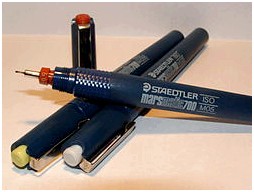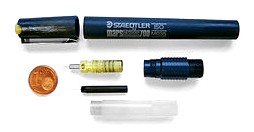Navigation article:


A technical pen is really a specialized instrument utilized by an engineer, architect, or drafter to create lines of constant width for architectural, engineering, or technical sketches. It’s been also generally known as “rapidograph”, although that specific name is formally a trademarked type of products produced by German company Rotring, by American manufacturer Chartpak, Corporation. once they purchased the legal rights from Rotring to create the pens in the united states underneath the Koh-I-Noor brand.
Most technical pens use inkjet cartridges which may be refilled or replaced.
Early technical pens (ruling pens) contained a little set of calipers, getting one flat and something bowed leg holding ink together. By modifying the space between your legs the width from the line attracted through the pen might be adjusted. Such pens, stored in a constant position towards the paper, were utilised for ruling lines, although not for cursive handwriting, nor for off-hands flourishes. The Graphos technical pen introduced in 1934 miniaturized the caliper principle making what exactly easily interchangeable.The Sheaffer company created an costly drafting set which incorporated such pens to be used on linen prints. These sets were frequently given to a draftsperson upon becoming ‘time served’, that is marking the finish from the apprenticeship.
Fountain pen versions
Within the 1950s, fountain pens with round points grew to become available, however they were complex instruments with tubes holding a small shaft. To produce ink the shaft is depressed along with a type of concerning the width from the exterior diameter from the tube could be attracted. Furthermore, in later models, the tube were built with a small ledge that effectively narrowed its finish, that – while keeping the road thickness – made the tube thicker along the majority of its length as well as protected ink from spilling while drawing across the fringe of a guide, set-square, T-square or any other template (a lot of it didn’t have immediate connection with the template’s edge). Some kind of special, more costly nibs were outfitted with tubes made from tungsten or using their tips made from synthetic precious gemstones, to slow their put on on hard surfaces.
Within the 1960s, the pen’s design evolved to feature tubes of ink which were full of a Pasteur pipette or from the narrow spout on the special bottle of ink. Such pens frequently arrived teams of sizes, and many pen points that have been installed in to the holders which contained a filled fountain, which could be screwed right into a handle. The development and quantity of parts varied based on the organization, including parts weren’t mix-compatible generally. Some later designs (such as the Staedtler MarsMatic700) had especially designed channels to permit better ventilation among the wall from the exterior grip and also the point set up. This made ink flow more reliable. The overall disadvantage to this number of pens is that they need to be frequently and thoroughly cleaned to get rid of all ink in the tubing, otherwise it might set and may ‘t be removed.
Within the U . s . States, several firms created this sort of technical pen: WRICO, Leroy, and Koh-I-Noor. Each had its very own proprietary sequence of line widths, and therefore the widths weren’t standardized over the industry, and every company’s specifications for that widths didn’t match others. And also the specifications received as fractions inch rather of fractions of the millimeter. Within the situation of technical pens designed for the united states market, these were marked with proprietary symbolic expressions (4×0, 3×0, 2×0, , 1, 2 etc.) and standard metric dimensions denominated in millimetres.
Throughout the planet, probably the most recognized brands were Staedtler, Rotring and Faber-Castell presently only Koh-I-Noor USA, Rotring, Rystor and Staedtler still result in the traditional technical pen.
Technical information
A complete group of pens might have the next nib sizes: .13, .18, .25, .35, .5, .7, 1., 1.5, and a pair of. mm, which match the road widths as defined in ISO 128. However, the Worldwide Organization for Standardization (ISO) known as for four pen widths and hang a color code for every: .25 (white-colored), .35 (yellow), .5 (brown), .7 (blue) these nibs created lines that associated with various text character heights and also the ISO paper sizes.
Text (created by an ISO stencil template to be used using the technical pens) of 5 mm tall includes a stroke or line thickness of .5 mm, and thus needs a brown-nibbed .5 mm pen. If the text were utilized in an ISO-sized document (e.g. A0), and also the document were reproduced at half its original size (A1), the written text could be made 3.5 mm high having a stroke thickness of .35 mm—the yellow-nib size. Thus, changes to reductions or enlargements can be created easily as things are compared. This worldwide standard (excepting Canada and also the U . s . States) helps to ensure that sketches can invariably be legible despite microfilming, photocopying, and faxing.
The primary drafting teams of four nibs arrived two kinds: Silver and gold. The Silver was for rough tracing paper, and also the Gold was for plastic film (velograph or durables). Drawing boards altered because of technical pens—a hard (not spongy) surface was needed, so when plastic film was utilized, the static attraction between plastic cursors, T-squares, set-squares etc. resulted in as you lifted the advantage in the film, the show would rise through static attraction and also the ink would blot. The answer ended up being to stick lower a plastic sheet (Osalid) that attracted the show more strongly compared to drafting instruments. The tracing paper or velograph sheet could be put on the Osalid sheet stuck to the drafting board and also the air brushed away. Brushing billed the top, and also the film would then be recorded taut (but released in the finish of every morning to match overnight temperature expansions and contractions).
When pen plotters grew to become prevalent, a unique number of point assemblies was created. These had the fundamental characteristics from the standard pen nib, however the tube was much thicker to bolster it against quick lateral movements. Just the tip from the tube had the preferred, line-size width. They fell from use as plotters were substituted for ink-jet printers.
As the Rapidograph type of pen continues to be broadly utilized by artists, using computer-aided design (CAD) has largely replaced the requirement for manual drafting. Also, the introduction of felt-tip, ink-based pens have given cheaper, lower-maintenance disposable tools that sell a lot better than traditional technical pens.
Related technologies
Drafting board technical drawing tools, for example set squares, shape templates, text stencils and French curves are utilized to make consistent marks around the paper. A technical pen could be mounted on a compass to create circles.
References
- Ronald J. Lutz’s Applied Sketching and Technical Drawing South Holland, Illinois: The Goodheart – Willcox Company, 1991.
- ballpoint/biro
- demonstrator
- digital
- dip
- fountain
- gel
- ink brush
- light
- porous point
- qalam
- quill
- rastrum
- reed
- rollerball
- ruling
- skin
- stylus
- technical (rapidograph)
This entry comes from Wikipedia, the key user-contributed encyclopedia. It might not happen to be reviewed by professional editors (see full disclaimer)
All translations of Technical_pen
sens a gent ‘s content
Try here or obtain the code
Having a SensagentBox, visitors to your website have access to straight answers on over 5 million pages supplied by Sensagent.com. Pick the design that matches your website.
Enhance your websites content
Add new content to your website from Sensagent by XML.
Crawl products or adds
Get XML use of achieve the very best products.
Index images and define metadata
Get XML use of fix this is of the metadata.
Please, send us an email to explain your idea.
Lettris is really a curious tetris-clone game where all of the bricks have a similar square shape but different content. Each square has a letter. To create squares disappear and save space for other squares you need to assemble British words (left, right, up, lower) in the falling squares.
Boggle provides you with 3 minutes to locate as numerous words (3 letters or even more) as possible inside a grid of 16 letters. You may also try the grid of 16 letters. Letters should be adjacent and longer words score better. Try to enter into the grid Hall of Fame !
British dictionary
Primary references
Most British definitions are supplied by WordNet .
British thesaurus is principally produced from The Integral Dictionary (TID).
British Encyclopedia is licensed by Wikipedia (GNU).
Alter the target language to locate translations.
Tips: see the semantic fields (see From suggestions to words) in 2 languages to find out more.
Source: dictionary.sensagent.com